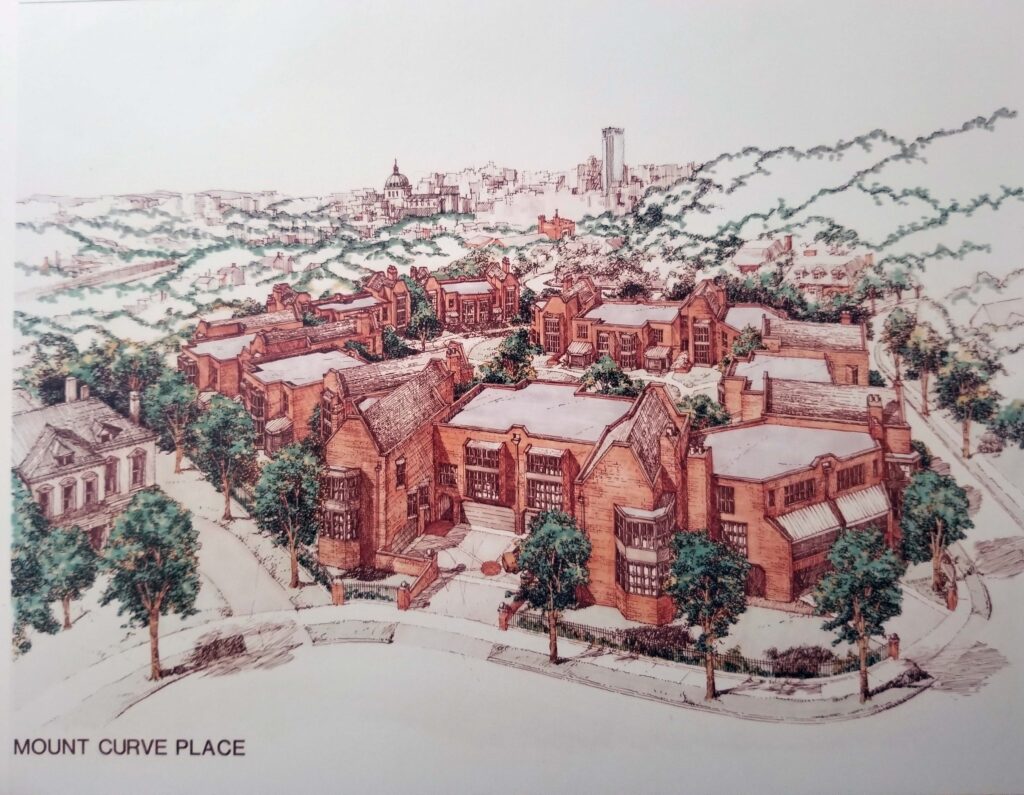The first development proposal for the 4 and 1/2 acre Dunwoody property in the Lowry Hill neighborhood was submitted to the City of Minneapolis and the Lowry Hill Homeowners organization (LHHO) in 1959 – more than 20 years of controversy and negotiations followed before the property was developed – to everyone’s satisfaction.
Part One – The Approval Process
In 1959, developer Anthony Cherne bought the property (including the Dunwoody Mansion) and proposed to build a 12 story 55 unit apartment in a neighborhood consisting of 2 and 3 story homes overlooking the Walker Art Center, Guthrie Theater and downtown Minneapolis.
The development required a zoning change; the homeowners group (LHHO) was adamantly opposed to the rezoning (spot zoning) – submitting petitions and attending many controversial meetings. The early rezoning was turned down.
The developer (Cherne), if he could not build the high rise building, next threatened to demolish the mansion, cut down the trees throughout the property and build numerous small inexpensive homes that would not be compatible with the neighborhood but would be acceptable under the present zoning of the area. Stressing the inexpensive rental housing could be removed in 10 or 15 years upon receipt of the rezoning, Cherne expected community approval; the community responded with even stronger opposition.
This battle between the developer and the community continued for years. At one point Cherne believed he was making some progress – but was met by a veto from Mayor Arthur Naftalin. Cherne then claimed that the veto by Mayor Naftalin was illegal – and the legality issue was taken up by the Minnesota Supreme Court – which promptly ruled in favor of the community.
The battle continued. The developer Cherne’s only response was to revise the proposal – now the building was to be an 18 story building with 100 rental units. During these later skirmishes, the community formed a committee to review the status of the battle and determine a course of action. The group, of many devoted community members and led by Howard Dahlgren, concluded that the land use map could and should be revised to allow townhomes in addition to single family homes. Subsequently, the city of Minneapolis did revise the land use map.
Part Two – Progress
During the later years of the protracted encounter, I had attempted and finally succeeded in meeting with the leader of the opposition, Tony Cherne. I only confided in one resident, Ernie Lehman; otherwise the homeowners group was not aware of my efforts to end the twenty year land use war. At first Cherne was angry and not willing to consider any resolution. Eventually, after several meetings, Cherne agreed that his high rise goals would never be realized and that he would prepare an option to sell the property to me, absent any contingencies. Success.
The next step in the twenty year Dunwoody saga was to design and build a townhome project that could meet the lofty expectations of the surrounding home owners, the balance of the Lowry Hill community, and everyone throughout Minneapolis who had been interested in this decades long effort to preserve the quality and unique aspects of one of the original neighborhoods of Minneapolis.
My partner, Norman Ackerberg (a seasonal local developer who shared my commitment to Minneapolis and the Lowry Hill community), and I were determined to make the Dunwoody Townhomes (to be soon named Mt. Curve Place), a project whose design, quality of construction and special site improvements would always symbolize the excellence achieved by the commitment and efforts expended by the community and the developers. Recognizing the spectacular location of the property, overlooking the Guthrie Theater, the Walker Art Center and downtown Minneapolis – and the extreme vertical nature of the property, we selected an architect with experience designing and building on similar steep sites in San Francisco – John Field, formerly of Minneapolis and a partner in the well known California firm, Bull Field Volkmann Stockwell. John joined us for a number of community meetings during which neighbors and planners and architects gave us their input and ideas for the development of Mt. Curve Place.
After several iterations, the final plans showed –
- Stunning, large, dark brick, 3 level homes completely compatible with the surrounding Lowry Hill Mansions.
- STEEP HILL – When we retained John Field with his San Francisco hillside construction experience we expected the project would utilize the hillside; John Field surprised us and placed the home sites of most of the homes at the top of the hill – along Mt. Curve Ave. overlooking downtown Minneapolis. “Don’t build on the hill,” John advised, “but take advantage of the view.”
- EARTHQUAKE-PROOF – Using his California experience, John significantly over-planned the homes – to withstand California earthquakes and unnecessarily adding to the sale price.
- RETAINING WALL – An additional feature that was required was the construction of a massive retaining wall that would prevent any future movement of the plateau which holds all of the townhomes at the top of the hill.
My recent success in building and selling the Greenway Gables Townhomes in Loring Park led my partner and me to expect an overwhelming buyer interest for the homes. We expected some resistance due to the large size of the homes and the purchase price; however we were surprised that, in spite of the spectacular site, its unique location overlooking downtown Minneapolis and the exciting appearance and quality of the homes – many potential buyers made it clear that they wanted to purchase a downtown townhome – and the Dunwoody/Mt. Curve place development was not downtown!
The homes were ultimately sold to committed urban Minneapolis buyers – even the future governor, Mark Dayton.
All in all, Mt. Curve Place was/is a great success – a credit to all of the community efforts over a twenty year period. Once in a while, “It’s a funny thing about life; if you refuse to accept anything but the best, you very often get it!

